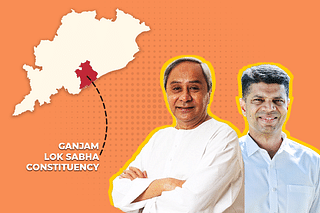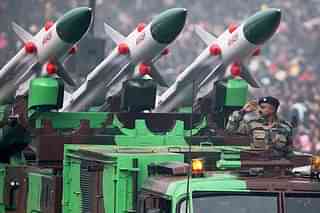Tech
India’s Digital Payments Systems Already A World Beater, Now Seem Poised to Stamp A Global Footprint
Anand Parthasarathy
Sep 09, 2023, 04:43 PM | Updated 04:43 PM IST
Save & read from anywhere!
Bookmark stories for easy access on any device or the Swarajya app.
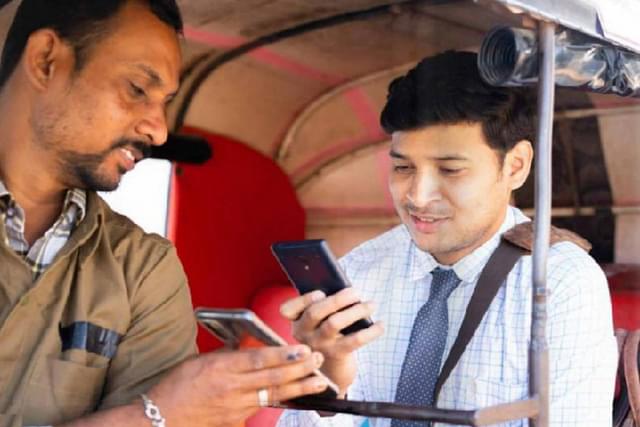
As the G20 Leaders’ Summit in Delhi, this weekend climaxes a year of India’s stewardship, one success story sells itself, and tells itself to the assembled heads of state and other policy makers: the India digital payments saga.
In less than a decade, it has put boots on the ground and sent them marching across the country to every corner, to reach a record 89.5 million digital transactions in 2022.
This is more than the next four countries combined—Brazil with 29.2 million transactions, China (17.6 million) Thailand (16.5 million) and South Korea (8 million), according to MyGovIndia which tweeted: “India keeps dominating the digital payment landscape! With innovative solutions and widespread adoption, we're leading the way towards a cashless economy."
None of the ‘developed’ North nations are in the list. In fact India’s digital payments exceed those of UK, USA, France and Germany combined. Some 40 per cent of all real time payments worldwide took place through the Universal Payment Interface or UPI — the agni asthra of India’s digital payments arsenal.
This instant payment system developed by the National Payments Corporation of India (NPCI) and launched in 2015 is by far the most popular among the various digital payments options available to Indians, with some 350 million active users.
In 2022, payment modes like UPI, Debit and Credit cards, Prepaid Payment Instruments — Mobile and Prepaid cards — processed 87.92 billion transactions worth Rs 149.5 trillion finds a Worldline study, -‘India Digital Payments Annual Report', published in April 2023.
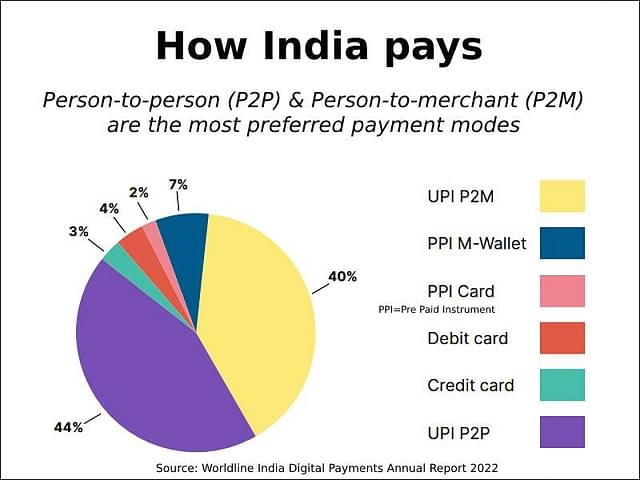
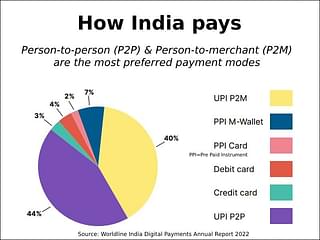
UPI tops in popularity
UPI Person-to-Merchant (P2M) and Person-to-Person (P2P) are the most preferred payment modes among consumers with a market share of 40% and 44 per cent in terms of transaction volume, totalling 84 per cent of all digital transactions.
These volumes are dominated by millions of small traders, handcart vendors, kirana shops, chai shops, with the ubiquitous UPI sound box and QR code scanner providing an audio confirmation of every transaction, many for Rs 10 or less. In 2022, UPI clocked over 74.05 billion transactions in volume and Rs 126 trillion in terms of value. Its transaction volume and value almost doubled since last year.
The top 5 UPI Apps in terms of volume and value were PhonePe, Google Pay, and Paytm Payments Bank App, Amazon Pay and Axis Bank, reflecting how global payment services have embraced UPI and helped its meteoric rise in popularity.
Of course one of UPI’s compelling attractions, an August 24 study in The Banker pointed out, is that currently they do not attract any merchant discount rate (MDR), the fee that a merchant is charged by the issuing bank for accepting payments from their customers via digital means. This is unlike cards, where merchants typically pay 2–3 per cent of the transaction value.
There were stirrings in banking circles, even at the regulator, to levy a small fee on UPI, but the government quickly scotched them arguing that UPI was a “digital public good with immense convenience for the public and productivity gains for the economy”.
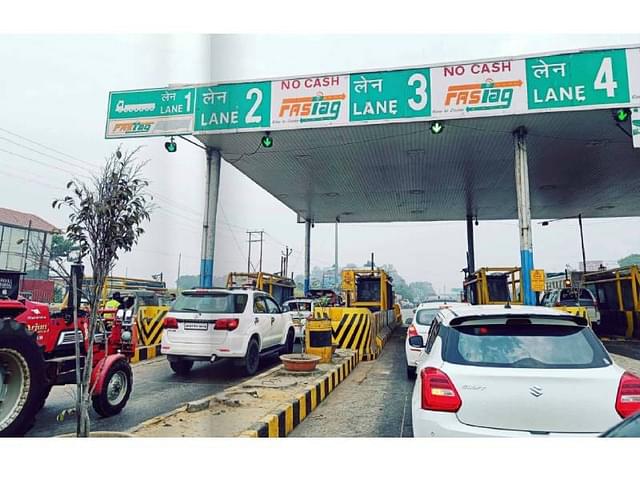
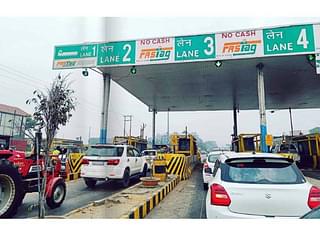
The spread of UPI has been assisted by some coincidental developments – the National Electronic Toll Collection (NETC), an interoperable national wide toll payment system, harnessing the RFID-chip-enabled FASTag has transformed toll plazas and speeded up their operations. Users top up their FASTags using UPI payment gateways of their choice.
Online payments have felt the garam hawa of digital options. After BHIM UPI, the Immediate Payment Service (IMPS) is the2nd biggest payment method, with 1.412 billion transactions in 2022-23.
Going global
In recent months, there have been sustained efforts to take UPI globally through the NPCI Payments International Ltd (NIPL).
Just a year ago, TerraPay, a leading global payments infrastructure group entered into partnership with NIPL, which allowed Indian customers and merchants in India with an active Unified Payments Interface Id(UPI Id) to make and accept cross-border payments seamlessly by leveraging TerraPay’s infrastructure and the UPI network.
Both companies are working together to further empower Indian customers with active UPI IDs (350 million bank accounts) to be able to transact at QR locations enabled by TerraPay, globally.
Nepal was the first to enable UPI country-wide with the backing of the Nepal Rastra Bank.
Today, merchants in Bhutan, Cambodia, Malaysia, Thailand, Philippines, Singapore, Oman, Maldives, Saudi Arabia, Bahrain, UAE and Vietnam already accept UPI payments, thanks to cross border payment agreements.
In April 2022, the BHIM UPI app went live all over the UAE, at NeoPay terminals operated by Mashreq Bank. Indian-origin residents and tourists in Dubai, Abu Dhabi and other Gulf centres, can now pay for purchases with the same app they use in India.
The reach of UPI is not limited to Asia or the Middle East NPCI has signed an MOU with French payments provider Lyra Networks to kickstart UPI’s French Connection. Netherlands, Belgium, Luxemburg, and Switzerland facilitate UPI transactions through Worldline.
“(UPI) is delivering a real revolution, that flies under the radar of (western) tech gurus”, concluded an article in Fortune magazine last year co-authored by Vivek Wadhwa, Distinguished Fellow of Carnegie-Mellon’s School of Engineering and a long-time observer of the India Technology scene.
At the Bharat Mandapam Convention Centre in Pragati Maidan, Delhi, where the Digital India stall is showcasing India's digital journey, UPI is no longer ‘under the radar’ as its ubiquity and ease is there for all to see and experience.
Save & read from anywhere!
Bookmark stories for easy access on any device or the Swarajya app.
Anand Parthasarathy is managing director at Online India Tech Pvt Ltd and a veteran IT journalist who has written about the Indian technology landscape for more than 15 years for The Hindu.
Support Swarajya's 50 Ground Reports Project & Sponsor A Story
Every general election Swarajya does a 50 ground reports project.
Aimed only at serious readers and those who appreciate the nuances of political undercurrents, the project provides a sense of India's electoral landscape. As you know, these reports are produced after considerable investment of travel, time and effort on the ground.
This time too we've kicked off the project in style and have covered over 30 constituencies already. If you're someone who appreciates such work and have enjoyed our coverage please consider sponsoring a ground report for just Rs 2999 to Rs 19,999 - it goes a long way in helping us produce more quality reportage.
You can also back this project by becoming a subscriber for as little as Rs 999 - so do click on this links and choose a plan that suits you and back us.
Click below to contribute.

